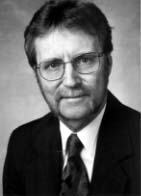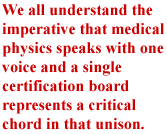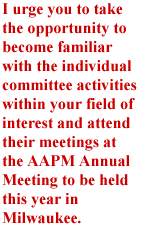
 |
 The Vista Ahead for Medical Physics
The Vista Ahead for Medical Physicsby Stephen R. Thomas Cincinnati, Ohio The Definition of Survival: The forces for change impacting the health care industry in recent years are obvious to all and may be expected to continue unabated over the near term. That the structure of health care delivery has been profoundly altered is not under debate. The issue which faces the medical profession in general, and our discipline of medical physics in specific, is how to develop and implement strategies for "survival" in this evolving environment. Here it is important to define what is meant by "survival" and to recognize the multifaceted dimensions encompassed by this term--the components of which cannot be universally applied to all but must be selectively adapted for individual circumstance. Certainly it includes bottom line economics and employment security, but also those less tangible aspects involving opportunity for continued professional development, maintenance of academic mission (for those in University settings), recognition by the physicians and administrators of our equivalent stature as professionals delivering a vital component of health care...to mention a few. But I am confident that none of us has forgotten the fundamental tenet associated with our medical profession, namely to promote, provide, and enhance quality health care for the community in need. Medical physicists contribute to this process through the unique expertise and quantitative capabilities which we bring to the field. Our "survival" by any definition depends on our continued fulfillment of this ideal. I am optimistic that we have identified avenues and will implement means for achieving success in this endeavor. It will call for foresight in areas of communication, proactive initiatives, and effective integration of innovative medical physics services within the health care system. One of my goals as President in 1997 is to ensure that the AAPM as an organization is responsive to these needs and will function as an aggressive proponent on behalf of the membership in all matters affecting professional survival. Thanks and A Sense of Responsibility: I begin this year as President of the AAPM with an acute sense of responsibility - common to all incoming Presidents. Therefore, I am pleased to report that the Association's foundation is indeed solid thanks to the conscientious and effective efforts of many individuals. Certainly principal among those are Past-President, Bhudatt Paliwal, Past Chairman-of-the-Board, Guy Simmons, and Treasurer, Jim Smathers. I want to extend particular gratitude on behalf of the AAPM to Charlie Coffey who has served for the past three years as Secretary par-excellence. Also, let me take this opportunity to welcome Jim Galvin as the incoming Secretary and Larry Rothenberg as President-Elect. There are many others who deserve to be recognized for their contributions to the AAPM over the past year and I plan to exercise the privilege of mentioning them in future columns. The positive "black ink" financial position of the AAPM is a bright spot. Success in this area, particularly as related to our annual meeting in Philadelphia, is due in a large part to the efforts of the Annual Meeting Coordination Committee under the Chairmanship of Ken Vanek, the Local Arrangements Committee under the leadership of Rene Smith, the Scientific Program Director and Co-Director, George Starkschall and Mitch Goodsitt, respectively, the Continuing Education Program Coordinator, Tony Seibert, and the Headquarters staff under the direction of Sal Trofi. (I will have more to say regarding the high efficiency of HQ operations in future reports.) This productive watch must continue and I have accepted the responsibility to ensure just that. Through Board action at the 1996 RSNA, we are committed to evaluating the potential for establishing a full years' operating budget in the Association's reserves within a 10 year timeframe. The Finance Committee has been charged with developing a program for Board consideration which should be necessarily comprehensive and far reaching. Stay tuned for the ongoing dialog in this area. Issues-of-Impact (IoIs): Through the course of 1997 I will be addressing what I define as Issues-of-Impact (IoIs) for the AAPM. These  are key issues which fall
into three principal categories:
(1) the State-of-the- Medical
Physics Profession; (2)
the AAPM as a National Presence;
and, (3) Organizational Aspects
of the AAPM. In this column, I
would like to touch briefly on
three
IoIs.
are key issues which fall
into three principal categories:
(1) the State-of-the- Medical
Physics Profession; (2)
the AAPM as a National Presence;
and, (3) Organizational Aspects
of the AAPM. In this column, I
would like to touch briefly on
three
IoIs.First, paramount within Category 1, we are under a resolve to establish a single unified certification process for medical physicists. The AAPM Board of Directors in Philadelphia endorsed creation of a Medical Physics Board Certification Council within the framework of the American Board of Radiology. This council, with representatives from AAPM, ACMP, and ACR COP (and possibly other organizations) would work with ABR Trustees on the structure, content and preceptor participation in certification examinations for medical physicists. The Council would nominate physics trustees to the ABR (with details to be worked out by the Council). Following  this directive from the Board,
President Paliwal appointed an
Ad Hoc Committee on Certification
to determine the membership and
structure of this Council within
the ABR as well as to address
conceptual issues.
this directive from the Board,
President Paliwal appointed an
Ad Hoc Committee on Certification
to determine the membership and
structure of this Council within
the ABR as well as to address
conceptual issues.As reported to the Board by Bhudatt at the RSNA, the Ad Hoc Committee met in initial session (November 1996). Eight recommendations were formulated which ranged from dedication to the concept of a single certification program for medical physicists, to specification of the membership and charge of the Medical Physics Certification Council (MPCC) within the ABR, to consideration of recognition of the equivalence of diplomats of the ABMP by the ABR through the MPCC. These events are highly positive. We all understand the imperative that medical physics speaks with one voice and a single certification board represents a critical chord in that unison. In my opinion, it is also vital that the medical physicist certification process maintain its position whereby it is recognized by the American Board of Medical Specialties (ABMS) which demonstrates to the world that the medical profession accepts medical physicists as professional equals. Currently this is the case under the ABR. The Ad Hoc Committee on Certification has the mandate to proceed to a final consensus configuration under the ABR Council format and I will do my part to support this process. We applaud the foresight and wisdom of the Ad Hoc Committee as it performs this all-important function on behalf of the medical physics profession. For the last two IoIs at this time, I turn to Category 3 on Organizational Aspects of the AAPM. One of the standard bearers of the AAPM has always been, and continues to be, its journal--Medical Physics. Over the past years under the leadership of Editor John Laughlin, the Journal has profited not only in an economic sense, but also scientifically. On behalf of the AAPM, I thank John for his stewardship in achieving the high stature which the Journal now enjoys. Indeed, we owe John a great debt of gratitude. The current Journal format brings to the fore all research areas of medical physics and highlights, for example, diagnostic imaging and nuclear medicine physics as well as the traditional area of radiation therapy. The Journal is responsive to the diverse undertakings and opportunities in the application of physics and mathematics to problems in medicine and biology. Increased reference of articles from Medical Physics within the Science Citation Indices over the past few years bears testimony to the rise in quality. The total number of manuscripts published has been increasing while the time from receipt to acceptance/publication has decreased significantly. The standard has now been passed to the new Editor, Colin Orton. The editorial operation of the Journal has been moved to Headquarters. We look forward with a great deal of optimism to the continued prominence of our Journal under Colin's editorship. My final IoI comments focus on the volunteer participation of the AAPM membership on behalf of their Association. The committee system is one of the absolute strengths of our organization. As President-Elect, I completed the process of the Committee appointments and reappointments  for 1997. The total number of
committee entities requiring
volunteer participation is 103
(3 councils, 36 committees,
24 sub-committees, and 40 task
groups). On behalf of the AAPM,
I thank the literally hundreds
of individuals who have
contributed their time and
expertise on these councils,
committees, and task groups
engaged in vital functions on
behalf of the scientific,
educational, and professional
missions of the AAPM. As we
move into 1997, I am confident
that this energy and support
for our activities will continue.
In particular, we always reach
out to the younger members with
a call for participation as
they begin their walk down
the pathway to leadership within
the AAPM. If you have not been
selected for committee membership
this year, please persevere with
your request. I urge you to take
the opportunity to become familiar
with the individual committee
activities within your field of
interest and attend their meetings
at the AAPM Annual Meeting to
be held this year in Milwaukee.
Through direct interaction with
the chairs of the various
committees and task groups, the
likelihood that a membership
position will be identified is
increased.
for 1997. The total number of
committee entities requiring
volunteer participation is 103
(3 councils, 36 committees,
24 sub-committees, and 40 task
groups). On behalf of the AAPM,
I thank the literally hundreds
of individuals who have
contributed their time and
expertise on these councils,
committees, and task groups
engaged in vital functions on
behalf of the scientific,
educational, and professional
missions of the AAPM. As we
move into 1997, I am confident
that this energy and support
for our activities will continue.
In particular, we always reach
out to the younger members with
a call for participation as
they begin their walk down
the pathway to leadership within
the AAPM. If you have not been
selected for committee membership
this year, please persevere with
your request. I urge you to take
the opportunity to become familiar
with the individual committee
activities within your field of
interest and attend their meetings
at the AAPM Annual Meeting to
be held this year in Milwaukee.
Through direct interaction with
the chairs of the various
committees and task groups, the
likelihood that a membership
position will be identified is
increased.
The Mission for 1997: In conclusion, I am honored to serve as President of the AAPM in 1997. In somewhat of a twist on the pronouncements of Camelot, it is my position that there are two legitimate questions for members to ask. Certainly one of them is, "What can I, as a member, do for the AAPM?" Here, the volunteer participation in the committee system is evident as a prime example. But an equally legitimate question is, "What can the AAPM do for me as a member?" The AAPM must be positioned to represent the profession of medical physics in an effective manner and lead forward with programs which benefit the membership. This will be the continuing mission for 1997. |